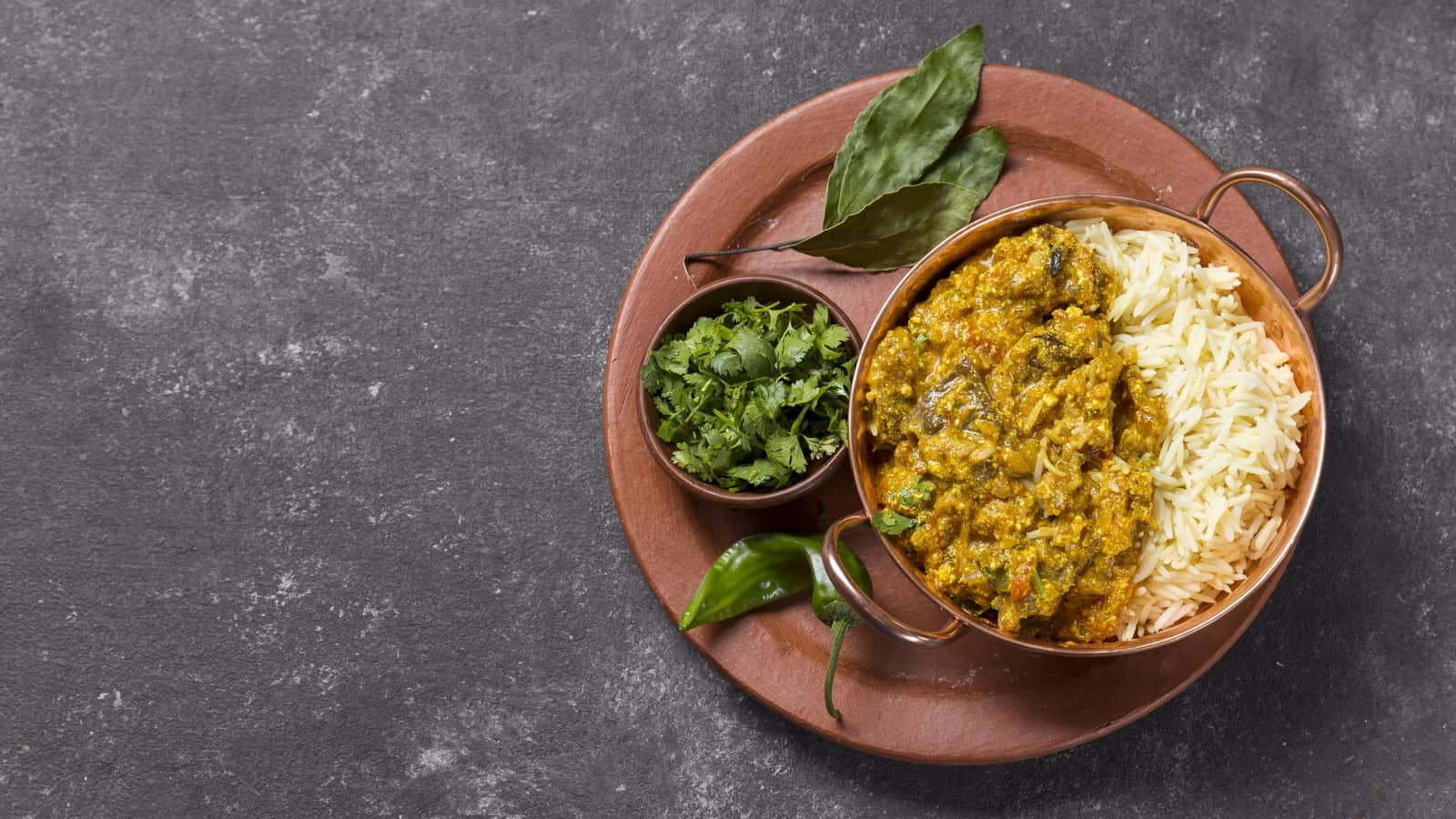
Best Indian Vegetarian Dishes You Must Try: Delicious Recipes & Meal Ideas

Gagan Singh
Author
Updated at August 2, 2025
Indian cuisine is a treasure trove of vegetarian delights, celebrated for its bold flavors, diverse ingredients, and deep-rooted cultural traditions. From creamy curries to spiced lentils and aromatic rice dishes, Indian vegetarian food offers something for every palate, whether you're a dedicated vegetarian or just exploring meat-free meals. With its abundant use of legumes, vegetables, and spices, these dishes are not only flavorful but also packed with nutrients.
If you're looking to experience the best vegetarian food in the city, visit an Indian vegetarian restaurant in Singapore for an authentic taste.
Best Indian Vegetarian Dishes
Here are standout Indian vegetarian dishes that showcase the richness of plant-based Indian cuisine. Each one is known for its unique flavor profile and cultural significance:
Punjabi Kofta Curry – Soft dumplings made of cottage cheese and vegetables in a signature curry, offering a melt-in-the-mouth experience with every bite.
Palak Paneer – A popular North Indian dish featuring tender cubes of cottage cheese simmered in a smooth spinach gravy seasoned with cumin and garlic.
Jackfruit Potato Bhuna Masala – A flavorful dry curry made with tender jackfruit, potatoes, and green chilli, this dish is a spicy and hearty alternative to meat.
Dal Tadka – Yellow lentils tempered with garlic, cumin, and chilli, creating a simple yet soul-satisfying dish that is both comforting and protein-rich.
Tandoori Paneer Kebab – Cottage cheese cubes marinated in yogurt, spices, and crushed nuts, then char-grilled for a smoky flavor and satisfying texture.
Mushroom Galouti Kebab – A Lucknowi-inspired vegetarian kebab made with finely minced mushrooms, saffron, and Galouti masala that simply melts in your mouth.
Vegetable Biryani – A one-pot rice dish layered with vegetables, saffron, and fried onions, delivering a fragrant and festive meal in every spoonful.
Rajma (Kidney Bean Curry) – This North Indian classic features red kidney beans slow-cooked in a rich, tomato-based and spicy gravy, best enjoyed with steamed rice.
Kadhi Pakora – A spiced yoghurt-based curry with gram flour fritters, offering a tangy, earthy, and comforting flavour to your plate.
Aloo Gobi – A dry curry of potatoes and cauliflower, seasoned with turmeric, cumin, and other Indian spices, often served with flatbread or rice.
These dishes capture the diversity of Indian vegetarian cuisine, offering a flavorful journey through the subcontinent’s culinary landscape. Explore them at an Indian fine dining restaurant in Singapore for a more refined experience.
Top Veg Indian Recipes to Try at Home
Exploring vegetarian cooking at home opens the door to many flavorful options. Here are some of the most loved dishes you can easily prepare:
Chole (Chickpea Curry) – High-protein, hearty curry great with rice or puri.
Baingan Bharta – Roasted eggplant mashed with spices and herbs.
Aloo Gobi – Dry curry of potatoes and cauliflower.
Rajma (Kidney Bean Curry) – North Indian staple, delicious with steamed rice.
Vegetable Biryani – Aromatic rice layered with vegetables and fried onions.
Masoor Dal – Quick-cooking red lentils with simple seasoning.
Paneer Butter Masala – Rich and creamy tomato-based gravy with paneer cubes.
Kadhi Pakora – Spiced yogurt gravy with gram flour fritters.
Bhindi Masala – Stir-fried okra with onions and spices.
Cabbage Poriyal – South Indian sautéed cabbage with mustard seeds and coconut.
Looking for Indian vegetarian dishes for outings? Check out Indian vegetarian picnic food ideas for portable, satisfying options.
Indian Veg Meal Ideas
If you're looking for meal planning ideas, here are a few:
Light Vegetarian Lunch
Steamed rice + Dal Tadka + Cabbage Poriyal + Papad
Comforting Dinner
- Paratha + Palak Paneer + Mixed Veg Curry + Raita
Festive Feast
Jackfruit Dum Biryani + Punjabi Kofta Curry + Naan + Gulab Jamun
Quick Snack Platter
Tandoori Paneer Kebab + Mushroom Galouti Kebab + Green Salad
Planning a family meal? Consider visiting one of the affordable family restaurants in Singapore that specialize in vegetarian Indian fare..
Conclusion
Indian vegetarian cuisine offers a delicious variety of dishes that blend flavor, nutrition, and tradition. Whether you're dining at home or hosting an event, consider the best Indian food catering in Singapore for a flavorful and satisfying vegetarian spread.
The recipes and meal ideas shared here offer just a glimpse into the vast world of Indian vegetarian food. Whether you're looking to spice up your weekday meals or plan a festive feast, Indian vegetarian dishes make a wholesome and delicious choice. So grab your spices, get cooking, and enjoy the colourful, nutritious world of vegetarian Indian cuisine!
Related Blogs:
Healthy dinner Indian | How to cook Indian food like restaurants | Indian vegetarian picnic food ideas | Japanese food vs Indian food | Lau Pa Sat opening hours | Amoy Street restaurants | Asia Square restaurants | Singapore Food Festival | Best casual restaurants in Singapore | Romantic restaurants Singapore | Affordable fine dining Singapore | Best lunch places Singapore | Family restaurant | Affordable restaurants in Orchard | Guoco Tower food | Best biryani in Singapore | Shenton Way food | Whisky bar Singapore | Best vegetarian restaurant
Frequently Asked Questions
Popular dishes include Palak Paneer (spinach with cottage cheese), Aloo Gobi (potato and cauliflower curry), Chole (spicy chickpeas), Rajma (kidney bean curry), and Paneer Butter Masala (creamy tomato-based paneer curry). These dishes are beloved for their bold flavors, comforting textures, and rich use of aromatic spices. They are staples in both North and South Indian cuisines and are widely enjoyed by vegetarians and non-vegetarians alike.
Start with simple, flavorful dishes like Dal Tadka (tempered lentils), Mixed Vegetable Curry, and Paneer Bhurji (scrambled paneer with spices). These recipes are easy to prepare, use commonly available ingredients, and introduce you to the signature spice blends of Indian cooking without being too overwhelming. They’re great for learning basic cooking techniques like tempering (tadka) and sautéing with masalas.
Yes, absolutely! Indian vegetarian meals often feature lentils (dal), beans (chickpeas, rajma), paneer (cottage cheese), tofu, and soya chunks, all of which are rich in protein. You can also enhance protein content by adding nuts, seeds, and quinoa to your dishes. These ingredients make Indian vegetarian food a complete, nutritious option for those aiming to meet their protein needs without meat.
No, not all Indian curries are vegetarian. Many curries include meat, fish, or eggs. However, there’s a vast variety of vegetarian curries available—like Baingan Bharta (smoky mashed eggplant), Kadhi Pakora (yogurt-based curry with chickpea dumplings), and Matar Paneer (peas and paneer in tomato gravy)—catering to both vegetarians and those who enjoy plant-based meals.
Indian vegetarian cuisine is renowned for its spices. Commonly used ones include cumin seeds, coriander powder, turmeric, garam masala, mustard seeds, red chili powder, and asafoetida (hing). These spices not only add depth and aroma but also offer various health benefits like improved digestion and anti-inflammatory properties.
Yes, many Indian vegetarian dishes are ideal for weight loss as they are naturally low in fat, high in fibre, and packed with nutrients. Options like moong dal, steamed idlis, vegetable soups, and grilled or stir-fried vegetables can help you feel full while staying within your calorie goals. Just be mindful of oil, ghee, and heavy cream usage during preparation.
Absolutely! Many Indian dishes can be easily adapted for a dairy-free diet. Substitute milk or cream with coconut milk or almond milk, and use tofu or cashew cream instead of paneer or yogurt. There are also traditional Indian dishes like Chana Masala, Bhindi Masala, and Baingan Bharta that are naturally dairy-free.
Great vegetarian lunch ideas include Vegetable Pulao (spiced rice with vegetables), Dal with steamed rice, Roti with Bhindi Masala (okra curry), or Curd Rice (especially in South India). These meals are balanced, easy to digest, and provide sustained energy throughout the day. Adding a side of salad or pickles enhances the flavor profile.
To reduce spiciness, cut down on green chillies and red chilli powder, and avoid overly spicy spice blends. You can also add cooling elements like yogurt-based raita, cucumber salad, or a dash of coconut milk to mellow the flavors. Opt for milder dishes like Korma, Malai Kofta, or Khichdi if you’re sensitive to heat.
Yes, many Indian vegetarian dishes are naturally gluten-free. Rice, lentils, chickpeas, vegetables, and gluten-free flours like besan (gram flour) and bajra (millet flour) are frequently used. Just avoid dishes that include wheat-based ingredients like naan or chapati unless made with gluten-free flour. Always check packaged spice mixes for hidden gluten.
